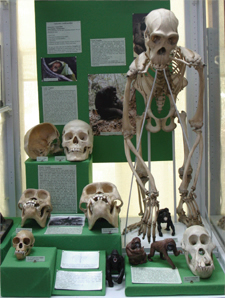
ORDER PRIMATES
SUBORDER HAPLORHINI
NEW WORLD MONKEYS, OLD WORLD MONKEYS, APES AND HUMANS
Haplorhines, monkeys and apes, are distinguished from strepsirhines by their facial features, the structure of their skulls and dentition and the placenta. The name haplorhine means simple nose. Haplorhines show a trend towards flattened faces with forward facing eyes. This trend is linked to an increasing reliance on vision and a decreasing reliance on smell. Monkeys and apes have dry noses; strepsirhines have wet noses. Haplorhine brains are larger than strepsirhine brains. The lower halves of haplorhine jaws are fused together. The incisors are spatulate or shovel-like. There is a space - a diastema - between the upper lateral incisor and the upper canine tooth, except in humans. The size of the molar teeth increases towards the back of the mouth. Haplorhine embryos are in contact with and surrounded by the maternal blood supply; strepsirhine embryos have many membranes between them and the maternal circulation.
 |
 |
 |
|||||
STRUCTURE AND LOCOMOTION OF MONKEYS AND APES
Monkeys can be distinguished from apes by their overall structure and how they move. Monkeys are adapted to move on all fours, their fore and hind limbs are of equal length, they have narrow rib cages and long backs. Arboreal species have long tails for balance but some terrestrial species, such as baboons, have reduced tails while other species lack tails altogether. Apes have short backs with barrel-shaped chests and strong pelvises. The length of spine between rib cage and pelvis is much shorter in apes than in monkeys, their fore limbs are longer than their hind limbs (except for humans) and their wrists are very mobile. All apes lack tails as they are not needed for balancing. Different ape species move in different ways. Gibbons and orang-utans swing under-arm from branch to branch by their very long fore arms. Chimpanzees and gorillas move on all fours using the knuckles of the fore hands for support. Humans walk vertically on their hind feet. The two bones (ulna and radius) in the lower fore limb and the two bones (tibia and fibula) in lower hind limb of both monkeys and apes are separate and highly mobile.

A Proboscis monkey and Bornean orang-utans illustrate the major differences in the overall structure of mankeys and apes (courtesy of J. Glendinning).
GEOGRAPHICAL LINEAGES OF HAPLORHINES
Modern haplorhines are divided into three infraorders: the Platyrrhini, the New World Monkeys; the Catarrhini, the Old World Monkeys, apes and humans; the Tarsiiformes, the tarsiers. The two geographically separated lineages of monkeys are distinguished principally by the shape of the nose. The nostrils of the New World monkeys, found in South America, are wide open and are apart. The nostrils of the Old World Monkeys, which occur in Africa and Asia, are narrow and close together. The lesser apes – gibbons, siamang - and the great apes - orang utan, chimpanzee, gorilla - all occur in the Old World. Their nostrils are narrow and close together.
The apes are humans’ closest relatives but exactly where to place humans in the classification schemes that encompass lesser and great apes is controversial. This website follows the scheme whereby modern humans, Homo sapiens, are assigned to the family Hominidae together with the apes. While monkeys and apes are tropical or subtropical animals, humans live in all regions of the world.
Within the infraorder Catarrhini, the apes and humans in the family Hominidae are assigned to the superfamily Hominoidea, while monkeys are assigned to the family Cercopithecidae in the Superfamily Cercopithecoidea. We have specimens of platyrrhines and catarrhines but no tarsiers.
| NEW WORLD MONKEYS | OLD WORLD MONKEYS | APES AND HUMANS |






